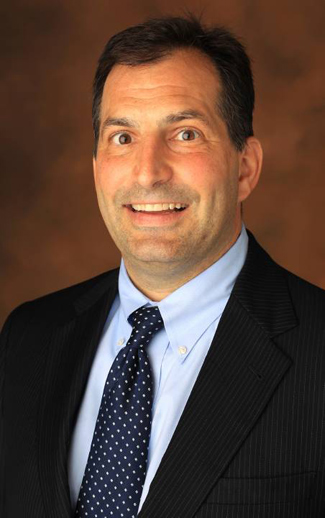Vanderbilt department heads gathered for a meeting Jan. 22 were given more information on the plan to establish Vanderbilt University and Vanderbilt University Medical Center as separate legal and financial entities.

Vice Chancellor for Administration Eric Kopstain outlined next steps in the process, which was first announced by Chancellor Nicholas S. Zeppos in a message to the Vanderbilt community Nov. 14. “After a comprehensive yearlong study, Vanderbilt’s Board of Trust has directed the institution’s senior leadership to reconfigure VUMC as a not-for-profit academic medical center that is financially distinct from Vanderbilt University,” Zeppos wrote at the time.
At last Thursday’s meeting, Kopstain elaborated on the deliberation that went into the decision. He explained that as an integrated entity, Vanderbilt University and Medical Center operates at an Aa bond credit rating, while most of VUMC’s health system competitors operate at A or lower. The need to maintain that Aa rating, which is an important measure of the university’s financial and academic strength, limits the Medical Center’s ability to access capital.
“By moving Vanderbilt University and Vanderbilt Medical Center into separate legal and financial entities, we’ll allow the Medical Center greater access to capital and make it better able to compete in a dynamic marketplace,” Kopstain said.
A second factor is the burgeoning Vanderbilt Health Affiliated Network (VHAN), the cornerstone of a bold strategic plan to improve the health of the region. Through VHAN, Vanderbilt is collaborating with other high-quality health care providers to create a clinically integrated network of providers delivering outstanding care in an effective, coordinated fashion. “VHAN is extremely exciting and important to the future of the Medical Center,” Kopstain said. “But it also relies on access to capital and a highly nimble governance structure” that separating VU and VUMC will allow.
Finally, slowed revenue growth for nonprofit U.S. health care facilities over the last decade overall pointed to a need to consider a different model that would support the long-term success of VUMC.
Kopstain said a long list of tasks must be completed before the legal and financial separation of Vanderbilt University and Vanderbilt Medical Center can take effect and detailed the structure of the transition program. Chancellor Zeppos and the vice chancellors constitute the Steering Committee. The Transition Management Office, charged with making sure “the gears continue to mesh,” includes Kopstain, Vice Chancellor and General Counsel Audrey Anderson, Vice Chancellor for Finance and CFO Brett Sweet, Division of Finance Chief of Staff Lindsay Burgener, Associate Vice Chancellor for Health Affairs and VUMC Chief Administrative Officer John Manning, and HR Executive Director Deb Grant. Twenty transition teams representing key areas also have been named.
“These 20 transition teams are not islands of activity; they’re definitely overlapping in a variety of ways,” Kopstain said. “Another critically important role of the Transition Management Office is identifying points of interconnection among the teams and making sure they are being addressed in a consistent way.”
Representatives from the Boston Consulting Group and the law firm of Hogan Lovells, partners who are consulting with Vanderbilt to complete the transition, round out the Transition Management Office.
The transition will be facilitated through a series of tools that will help the teams envision and plan for Vanderbilt University and Vanderbilt University Medical Center as they will exist post-separation. The teams will consider the needs of these future-state entities in creating new organizational structures; identifying emerging legal issues; and developing the policies, procedures and processes to help them operate. Once these steps are completed, the teams will write implementation plans, track one-time and recurring costs of the transition, and begin to develop staffing plans for the new VU and VUMC. “We have monthly deliverables as part of this process that are scheduled all the way through May,” Kopstain said.
“We also acknowledge that by July 1, 2015, the legal transaction to separate the two entities will not yet be complete,” he said. “But to the extent that it is operationally and legally possible, we’d like to go into a ‘dress rehearsal mode’ where we begin to prepare to operate as two separate entities, even though we will still be one legal entity for an additional period of time.” A goal of the dress rehearsal is to identify additional issues that need to be addressed prior to legal separation.
Kopstain described administrative services for the future-state VU and VUMC as falling into one of three “buckets”: one where Vanderbilt University will own, operate and provide the service to both VU and VUMC; another where Vanderbilt Medical Center will own, operate and provide the service to VUMC and VU; and a third where each will own, operate and provide their own.
“There are administrative functions that will be impacted and will change as a result of VUMC’s transition to a separate legal entity,” Kopstain said. “But I believe the sum of the parts of these future-state entities will be greater than the whole is today.”
Leaders are currently considering what the post-transition organizations will look like, including how current teams will be divided, what additional resources may be needed, and where groups will physically be located. More information will be shared when available.
“One thing we want to be clear about is that the intent of this transition is not at all to eliminate positions,” Kopstain said. “In fact, we believe that the separation will create incremental opportunities for staff to grow and develop.” The principles that will guide staffing decisions for the future-state entities will be based on clarity, fairness and equity, seeking stretch and promotional opportunities for staff whenever possible, and ensuring the continuity of operations.
“One of the key objectives throughout this transition is to make the process of separation as smooth as possible for all of our faculty, students, doctors, clinical and administrative staff, patients and other key constituents, while preserving and, in fact, enhancing the shared cultural and mission values that we have today,” he said.












